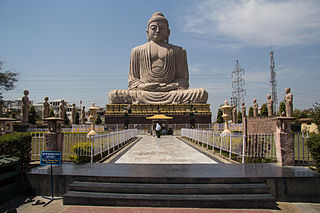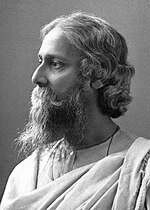
The khol is a terracotta two-sided drum used in northern and eastern India for accompaniment with devotional music (bhakti). It is also known as a mridanga, not to be confused with mridangam. It originates from the Indian states of Odisha, West Bengal, Assam and Manipur. The drum is played with palms and fingers of both hands.

Indian classical dance, or Shastriya Nritya, is an umbrella term for different regionally-specific Indian classical dance traditions, rooted in predominantly Hindu musical theatre performance, the theory and practice of which can be traced to the Sanskrit text Natya Shastra. The number of Indian classical dance styles ranges from six to eight to twelve, or more, depending on the source and scholar; the main organisation for Indian arts preservation, the Sangeet Natak Academy recognizes eight: Bharatanatyam, Kathak, Kuchipudi, Odissi, Kathakali, Sattriya, Manipuri and Mohiniyattam. Additionally, the Indian Ministry of Culture includes Chhau in its list, recognising nine total styles. Scholars such as Drid Williams add Chhau, Yakshagana and Bhagavata Mela to the list. Each dance tradition originates and comes from a different state and/or region of India; for example, Bharatanatyam is from Tamil Nadu in the south of India, Odissi is from the east coast state of Odisha, and Manipuri is from the northeastern state of Manipur. The music associated with these different dance performances consists many compositions in Hindi, Malayalam, Meitei (Manipuri), Sanskrit, Tamil, Odia, Telugu, Assamese, and many other Indian-Subcontinent languages; they represent a unity of core ideas and a diversity of styles, costumes, and expression.

Dance in India comprises numerous styles of dances, generally classified as classical or folk. As with other aspects of Indian culture, different forms of dances originated in different parts of India, developed according to the local traditions and also imbibed elements from other parts of the country.

Chhau, also spelled Chhou, is a semi classical Indian dance with martial and folk traditions. It is found in three styles named after the location where they are performed, i.e. the Purulia Chhau of West Bengal, the Seraikella Chhau of Jharkhand and the Mayurbhanj Chhau of Odisha.

East India is a region of India consisting of the Indian states of Bihar, Jharkhand, Odisha and West Bengal and also the union territory of the Andaman and Nicobar Islands.

Sangeet Natak Akademi is the national level academy for performing arts set up by the Government of India.
The administrative divisions of India are subnational administrative units of India; they are composed of a nested hierarchy of administrative divisions.
Kolkata has many festivals throughout the year. The largest and most magnificently celebrated festival of the city is Durga Puja, and it features colourful pandals, decorative idols of Hindu goddess Durga and her family, lighting decorations and fireworks. Other major festivals are Diwali, Kali Puja, Holi, Saraswati Puja, Poush Parbon, Poila Boishakh, Christmas, Eid al-Fitr, Eid al-Adha, etc.

The Ministry of Culture is the Indian government ministry charged with preservation and promotion of art and culture of India.

The following outline is provided as an overview of, and topical guide to, India:
Odisha is one of the 28 states of India, located on the eastern coast. It is surrounded by the states of West Bengal to the northeast, Jharkhand to the north, Chhattisgarh to the west and northwest, and Andhra Pradesh to the south and southwest. Odia is the official and most widely spoken language, spoken by 33.2 million according to the 2001 Census. The modern state of Odisha was established on 1 April 1936, as a province in British India, and consisted predominantly of Odia-speaking regions. April 1 is celebrated as Odisha Day.

Odissi music is a genre of classical music originating from the eastern state of Odisha. It is played on traditional instruments like the mardala, veena, and bansuri. Rooted in the ancient ritual music tradition dedicated to Lord Jagannatha, Odissi music has a rich history spanning over two thousand years, distinguished by its unique sangita-shastras, a specialized system of Ragas and Talas, and a distinctive style of performance. While some Indian classical music like Carnatic music and Hindustani music, traditions evolved separately over centuries, Odissi music has retained its classical purity and its characteristic devotion-centered compositions. Odissi compositions are largely written in Sanskrit and Odia.
The Cultural Zones of India are seven overlapping zones defined by the Ministry of Culture of the Government of India to promote and preserve the cultural heritage of various regions of India. Each of these zones has been provided with a zonal centre. Most zonal centres were announced by the then-Prime Minister of India, Rajiv Gandhi, in 1985 and formally began functioning in the 1986–87 period. Their stated goal is "to strengthen the ancient roots of Indian culture and evolve and enrich composite national culture".
Dhumpa sangita is a folk musical art form from the Ganjam and Nayagarh districts of Odisha in India. It derives its name from the dhumpa, a bamboo percussion instrument that accompanies the performance. The tradition is currently on the decline and faces the threat of extinction.

Sharmila Biswas is a leading dancer, choreographer and Teacher in the field of Indian Classical Dance. She is recognized for her considerable contribution to Odissi Classical Dance which brought many changes in the Content, Technique and Costumes. Tracing the many facades of Traditional Performing and Visual arts of Odisha, and in that context viewing Odissi Dance have been the foundation of most of her Dance productions. A prominent deciple of Guru Kelucharan Mohapatra, a Sangeet Natak Akademi awardee (2012), Sharmila Biswas heads Odissi Vision & Movement Centre (1994), a well-known institution dedicated to Research, Training and Productions. Graded as an ‘Outstanding’ artiste by The Indian Council of Cultural Relations, Ministry of External Affairs, Govt. Of India. Graded as one of the ‘Top’ artists by Doordarshan, India. In 2012, Biswas was awarded Sangeet Natak Akademi Award, conferred by the Sangeet Natak Akademi, India's National Academy for Music, Dance and Drama.

Elam Endira Devi, is an Indian classical dancer and teacher, known for her expertise and scholarship in the classical dance form of Manipuri, especially in the genres of Lai Haraoba and Raas. The Government of India honored her, in 2014, with the Padma Shri, the fourth highest civilian award, for her services to the field of art and culture.

Northeast India consists of eight states: Arunachal Pradesh, Assam, Manipur, Meghalaya, Mizoram, Nagaland, Sikkim and Tripura. Tourism in this area is based around the unique Himalayan landscape and culture distinct from the rest of India.
The 2015–16 Senior Women's Football Championship was the 21st edition of Senior Women's National Football Championship, the women's state competition in Indian football. The tournament qualification round was stated on 12 December 2015 and culminated on 27 December 2015 across five zones – North Zone, South Zone, East Zone, West Zone and North East Zone – throughout the Nation.
The 2019 Santosh Trophy qualifiers was the qualifying round for the 73rd edition of the Santosh Trophy, the premier competition in India for teams representing their regional and state football associations.




















